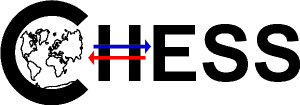
School participants during week 2 of the Summer School.
The Bornö Summer School in Oceanography took place from July 31—August 11, 2017, on the island of Storo Bornö, in the Gullmarn Fjord on the west coast of Sweden. The school, sponsored by CHESS, was a collaborative project between the Universities of Copenhagen, Gothenburg, Hamburg, Oslo and Stockholm, with lecturers from all five institutions. The 12 students who took part are studying in Sweden, Norway, Denmark and Germany, but hail from diverse countries, including India, Greece, Turkey, Columbia and Brazil. The meeting was held at the Bornö Marine Research Station, which was founded in 1902 and is still in use today. The participants stayed on site, and the meals were prepared there as well. Three of the lecturers ran the course during the first week, and three others did so in the second week.
The days were long and productive. Lectures were held from 10-12 every morning. After lunch, there was a short lecture and then the students worked with programming. Each developed his/her own simplified ocean model, to simulate the various geophysical phenomena discussed in the lectures. The afternoon sessions frequently continued until dinner (at 7 pm), and then into the evening. But there were breaks as well, to sail in the fjord, to swim to the nearest island or to hike in the woods on the island. The students made presentations on the last day, on topics they had chosen. These spanned the range from equatorial waves to the adjustment of the deep circulation.
The students evaluated the program on the last day as well, to give the organizers feedback on how to improve the program. The response was unanimous that the course was enjoyable and useful, even for those students who had seen some of the material previously. They praised the lectures, the exercises, the course content and the living quarters (and gave high marks for the food). The students also greatly enjoyed the social aspects, getting to know others at a similar stage in their studies and the lecturers. There were also suggestions for future programs, including having ocean observations in the fjord and including some theoretical exercises in addition to the modeling.
–Joe LaCasce, Univ. of Oslo
